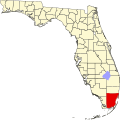Virginia Gardens, Florida | |
|---|---|
| Village of Virginia Gardens | |
 Location in Miami-Dade County and the state of Florida | |
 U.S. Census Bureau map showing village boundaries | |
| Coordinates: 25°48′33.03″N80°17′48.11″W / 25.8091750°N 80.2966972°W | |
| Country | |
| State | |
| County | Miami-Dade |
| Incorporated | July 10, 1947 |
| Government | |
| • Type | Mayor-Council |
| • Mayor | Fred "Spencer" Deno IV |
| • Council President | Jorge Arce |
| • Councilmembers | Debra Conover Gabriel Fernandez Richard Block Elizabeth Taylor-Martinez |
| • Village Manager | Mayor Fred "Spencer" Deno IV |
| • Village Clerk | Maritza Fernandez-Guevara |
| Area | |
• Total | 0.29 sq mi (0.76 km2) |
| • Land | 0.29 sq mi (0.76 km2) |
| • Water | 0.00 sq mi (0.00 km2) |
| Elevation | 3 ft (1 m) |
| Population | |
• Total | 2,364 |
| • Density | 8,040.82/sq mi (3,109.74/km2) |
| Time zone | UTC-5 (EST) |
| • Summer (DST) | UTC-4 (EDT) |
| ZIP Code | 33166 |
| Area codes | 305, 786, 645 |
| FIPS code | 12-74575 [3] |
| GNIS feature ID | 0292782 [4] |
| Website | www |
Virginia Gardens is a village in Miami-Dade County, Florida, United States. The village is a part of the Miami metropolitan area of South Florida. According to the U.S. Census Bureau, the village had a population of 2,364 in 2020. [2]

